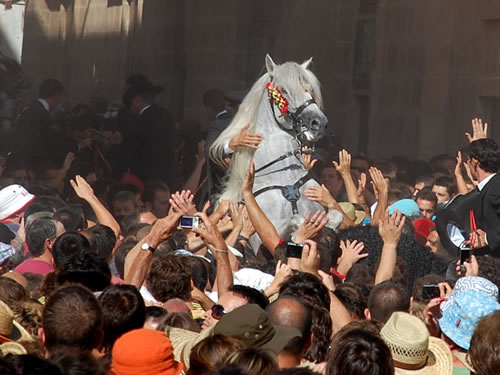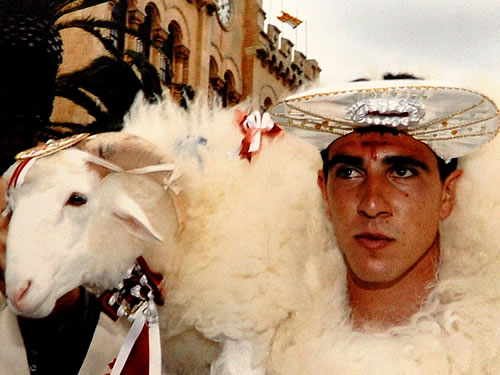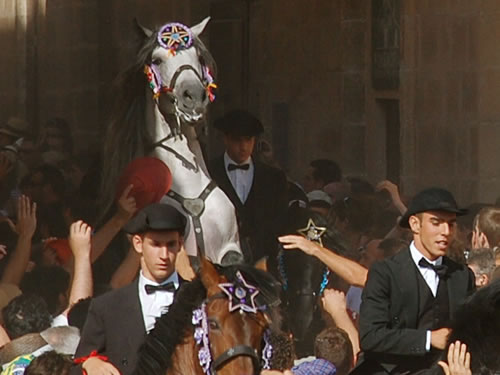A Summer Solstice Festival in Saint Joan, Menorca, Spain
Article and photos by Lies Ouwerkerk
Senior Contributing Editor
 |
|
During the Festival of Sant Joan in Menorca, Spain a white horse is celebrated. |
History of the Festival
Throughout history, summer solstice celebrations have been an important element of social, cultural, and religious life in many Spanish cities and towns, especially those close to the sea. Originally a pagan Celtic ritual on the shortest night of the year, the holiday was christianized during the 5th century by the deeply religious king Clovis and named "Saint John's Day" after Saint John the Baptist, who was born on the 24th of July.
Most celebrations take place on the eve of the Saint's birthday with fireworks, bonfires, music, singing and dancing. In some places there are additional activities such as jumping through flames of bonfires for good luck, or taking a cleansing dip in the ocean to purify oneself for the new season. During the Galician Conjuro de la Queimada the soul is purified by drinking orujo, a traditional Galician liqueur which is lit on fire in a clay pot, while "witches" recite an ancient incantation to banish the evil spirits.
Sant Joan, Patron Saint Of Ciutadella De Menorca
Whereas in most places the element of fire has remained one of the major attractions of the Saint John celebrations, the city of Ciutadella on Menorca — a small Balearic island with a fascinating history of foreign rulers — developed rituals of its own, which are nowhere else to be found. There, during their patron saint's Festes de Sant Joan, more than 100 Menorca-bred horses and their expert riders, known as the cavallers, are the main protagonists, together with a committee of caixers representing the ancient society of Ciutadella. This committee consists of a caixer capella (a priest in charge of the religious events), a caixer senyor (a member of the ancient nobility) who is helped by the fabioler heralding the events that are coming up, two caixers pagesos (farmers keeping order in the cavalcades), a caixer menestral (representing artisans), and a caixer fadri (the flagbearer).
Day Of The Lamb
The rituals of their Festes de Sant Joan have remained unchanged since medieval times. On the Sunday prior to Saint John's Day, called the Diumenge des Be (Sunday of the Lamb), the committee gathers at the palace of the caixer senyor, where the flag is presented to the caixer fadri. After the fabioler has played his first sounds on pipe and drum, the group sets out to summon the authorities for the festivities. Accompanying them barefooted is the Homo des Be, a man dressed in sheep skins, and carrying on his shoulders a 1-year-old lamb which represents the living symbol of Saint John the Baptist. The lamb has been washed and combed regularly on each of the seven previous days, and is watched all night to prevent it from getting dirty. In the early morning of the Day of the Lamb, the animal is adorned with colored ribbons and painted red crosses on its back.
 |
|
Man in white carrying a lamb during the Festival of Sant Joan in Menorca, Spain. |
The Most Anticipated Event: Caracol Des Borns
Beating the crowds and securing a spot to watch the Caracol (circuit) des Borns on the 23rd of June is no small matter. Many tourists and Menorcans alike are already out and about several hours before the actual horse parade takes place on the Plaza des Borns, to the satisfaction of restaurant and bar owners. An older couple from Ciutadella standing to my right keeps a watchful eye on the staircase leading to the platform where the local brass band will perform. That staircase has for years been their favorite spot, they confide hush-hush to me, but in order to occupy it, they will have to wait until all members of the band have passed and taken their place on stage, and then rapidly swoop in like two avid hawks. In front of me, amidst hordes of singing and dancing people, a family from Madrid has triumphantly settled on camping stools, armed with enough food and drinks to last them for a whole week. But panic strikes when one of their kids urgently needs to visit a toilet. And the French couple on my left sneaks by the minute a few inches forward, until they are put in place by some observant locals who stand their ground as if attacked by the enemy. In short, feelings run high during the long waiting hours in the hot afternoon sun. Meanwhile, the chanting grows louder and louder, the plaza gets more and more packed, and the anticipation becomes more and more palpable.
 |
|
Horse parade at the festival in Menorca. |
The Locally-Bred Horses
And there they finally are: the dark and shiny locally-bred horses dressed up with ribbons and rosettes and mounted by the proud cavallers in their matching black costumes. One by one they parade along the balcony of the caixer senyor's palace, adorned with red flags depicting a white Maltese cross (the 8-pointed cross is a symbol used by the knights of Saint John the Baptist, and denotes their eight most important obligations and aspirations). While they are greeted by the caixers and their company, the riders let the horses rear up on their two hind legs as long and frequently as they can. Then, before they all depart for the famous Sant Joan de Missa — the hermitage of the Saint where vespers are sung presided by the caixer capella , the whole procession moves slowly on through the narrow and crowded streets of Ciutadella, cheered on by the many onlookers along the way. Partygoers also engage in mock hazelnut battles at several locations in the city, and nobody knows or recalls anymore the origin of this peculiar custom, although some sources suggest that the hazelnut used to be considered an effective weapon against witchcraft.
June 24: Jocs Des Pla
In the morning of the 24th, the actual birthday of Saint John, the fabioler asks the permission of the caixer senyor to continue with the Jocs des Pla, an amazing spectacle of medieval games: the s'ensortilla, whereby riders in full gallop spear a suspended ring on their lance, the carotes, in which two cavallers ride next to each other, one carrying a shield that has to be broken with a lance of the other, and finally the spectacular correr abracats, featuring two riders galloping together shaking hands and embracing each other.
Although most spectators continue singing, dancing, and drinking pomada — a mix of local Xoriguer gin and lemonade — into the wee hours of June 25th, the official celebrations end after the fireworks display at night, followed by the last piping of the fabioler and the sound of a scream "fins l'any que ve, si Deu voi" (see you next year, god willing).
For More Information
Menorca
Menorca has been declared a Biosphere Reserve by Unesco in 1993, and has therefore remained relatively untouched by mass tourism, contrary to its well-known neighbours Mallorca and Ibiza, all located off the coast of Spain in the western Mediterranean sea. In Menorca one can find ancient towns and villages of both colonial and local architecture, pastoral landscapes, deep gorges, megalithic stone monuments, and pristine beaches which can often only be reached on foot, bike, and horse, or by boat. Most inhabitants of Menorca are bilingual and speak both Spanish and Menorqui, a variant of Catalan. Since Menorca belongs to Spain, the currency used is the Euro.
Transport
- Public transport from Mahon (the capital) airport to Ciutadella: first take bus into Mahon bus station, then proceed with bus to Ciutadella. Total costs around €7; a taxi to Ciutadella will cost E50 - E60.
- Horse riding: Club Hipico de Ciutadella.
Lodging
To avoid late night fiesta noise, the charming rural hotels and agriturismos around Ciutadella may be a great alternative to downtown hotels during the last week of June. Prices range from €55 to €378 for a double room:
|
Lies Ouwerkerk is originally from The Netherlands, and currently resides in Montreal, Quebec. She works as a columnist for The Sherbrooke Record, and as a freelance writer and photographer for various travel magazines.
|
